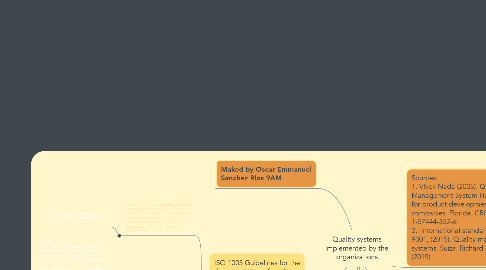
1. Maked by Oscar Emmanuel Sanchez RIos 9AM
2. ISO 1003 Guidelines for the documentation of quality management systems
2.1. Provides guidance to integrate the quality management system documentation helping to maintain a documented system in accordance with ISO 9001. The way to integrate the quality management system documentation can be organized according to;
2.1.1. The processes of the organization The structure of the standard applied A combination of both
2.2. The quality management system documentation may include standardized definitions and terms which are supported by the ISO 9000 standard. The quality management system documentation includes:
2.2.1. 1. Quality policy and its objectives; can align with vision and mission to deliver quality objectives. 2. Quality manual; It is a document that specifies the quality management system of an organization. 3 Documented procedures; It is the specific way to carry out a set of coordinated and controlled activities with start and end dates carried out to achieve a goal. 4. Work instructions; they are a detailed description of how to perform and record tasks. 5. Forms and records; The forms are documents used to record the data required by the quality management system. They become a record when the data is added. 6. Quality plans; It is a specification of the procedures and associated resources to apply. 7. Specifications; they are documents that establish requirements and are related to activities or products, 8 External documents; contain information related to products or services contracted externally.
3. ISO 9001 Quality Management System
3.1. The adoption of a quality management system is a strategic decision for an organization that can help it improve its overall performance and provide a solid foundation for initiatives. of sustainable development.
3.1.1. Benefits of implementing this standard: a) the ability to regularly provide products and services that meet customer and applicable legal and regulatory requirements; b) facilitate opportunities to increase customer satisfaction; c) address the risks and opportunities associated with its context and objectives; d) the ability to demonstrate conformance with quality management system requirements specified.
3.2. This standard contains the following sections of interest to the QMS: Leadership Planning Support for Operation Performance evaluation Improvement
4. Sources: 1. Vivek Nada (2005). Quality Management System Handbook for product development companies. Florida. CRC Press- 1-57444-352-6 2. International standard ISO 9001, (2015). Quality management systems. Suiza. Richard Keen. (2019)
5. Quality Management System
5.1. A quality management system (QMS) is the means by wich quality management practices becomme an integral part of a organization. A QMS is not a temporary fad, but a permannt part of an organization that directly influences the way the organization conducts its business. QMS is not a vague phrase; it has a very specific meaning: "A quality system consists of the organizational structure, the procedure, the processes, and the resources necessary to implement quality management" (ISO 8402)
5.1.1. Reason to implementing a QMS
5.1.1.1. Improve productivity, improve product quality, and reduce time to market, sponsorship of quality improvement initiatives and make an ecaluation againts registration for a recognized quality management system satndar, or an application for local state or national quality awards.
6. Quality Management
6.1. Quality management comprises all activities that are requeried to plan for quality in a organization, an all activities that are requiered to satisfacy quality objectives. Specifically, quality management comprises the following four elements:
6.1.1. Quality planning
6.1.1.1. Establish quality objectives, indentify quality requirements, plan for a QMS and plan for process execution.
6.1.2. Quality control
6.1.2.1. Monitor a procees to ensure its output is of requiered quality and correct discrepancies when they occur.
6.1.3. Quality assurance
6.1.3.1. Comprises all the planned and systematic activities implemented within the quality system thah can be demonstrated to provide confidence that produc or service will fulfill requirements for quality.
6.1.4. Quality improvement
6.1.4.1. Enhancement in the effectiveness and efficiency of processes; and Enhancement in the extent to wich a product satisfies applicable requirements.

